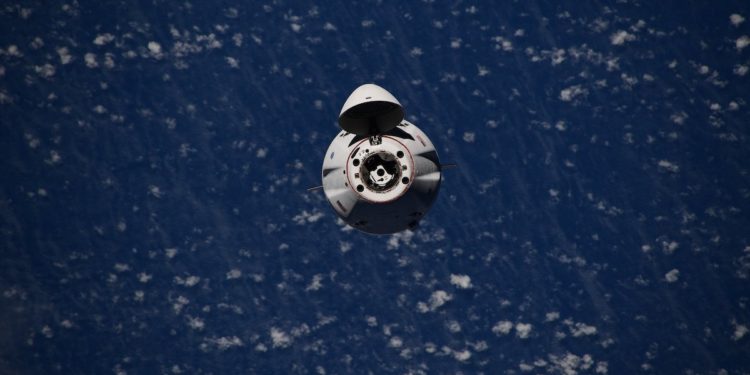
Closing out a 31-hour flight from a launch pad in Florida, a SpaceX Cargo Dragon capsule autonomously docked with the International Space Station Monday, delivering experiments, supplies, and fresh food to the complex.
The automated cargo freighter linked up with the forward port of the space station’s Harmony module at 10:30 a.m. EDT (1430 GMT), making contact with the outpost as it sailed 264 miles (424 kilometers) over Western Australia.
A few minutes later, the cargo ship retracted its docking ring, allowing 12 hooks to drive closed, creating a firm mechanical connection between the Dragon and the space station.
“Hard capture complete, and another excellent Dragon docking complete,” radioed Leslie Ringo, spacecraft communicator at NASA’s mission control in Houston.
“Congratulations to NASA and the SpaceX teams, and many thanks. No one has ever sent me a spaceship for my birthday before. I appreciate it,” replied astronaut Megan McArthur from the space station.
McArthur celebrated her 50th birthday Wednesday. She and crewmate Shane Kimbrough monitored the Dragon capsule’s final approach two the space station, ready to send commands for the supply ship to abort its rendezvous in the event of an emergency.
The Cargo Dragon capsule carried treats, such as ice cream, cheese, and fruit, for the space station’s seven-person crew. McArthur tweeted later Monday that she enjoyed a birthday dinner with her crewmates.
“My space brothers went all out: quesadillas and tortilla-pizzas with real cheese! Cookie decorating! Cake with chocolate ‘candles’! We haven’t unpacked the ice cream yet, so I guess that means a second party?” she tweeted.
What a great birthday dinner with my Expedition 65 crew mates! My #SpaceBrothers went all out: quesadillas and tortilla-pizzas with real cheese! Cookie decorating! Cake with chocolate “candles”! We haven’t unpacked the ice cream yet, so I guess that means a 2nd party? 🌮🍕🎂 pic.twitter.com/h0D85fz6ei
— Megan McArthur (@Astro_Megan) August 30, 2021
The Cargo Dragon capsule delivered 4,866 pounds (2,207 kilograms) of supplies and experiments. The mission, known as CRS-23, marks SpaceX’s 23rd resupply flight to the space station since 2012 under contract to NASA.
It is the third flight of an upgraded variant of SpaceX’s Dragon cargo ship based the company’s human-rated capsule. It’s the second mission for this particular spacecraft, which previously flew to the station in December 2020.
Besides fresh food, the Dragon supply freighter delivered an array of technology demonstration, materials science, and biomedical experiments to the space station. The station astronauts plan to unpack more than a ton of science hardware from the Dragon spacecraft’s pressurized cabin.
They include a small robotic arm from GITAI Japan Inc., a Japanese company, to demonstrate in-space tasks that could lead to development of future robots to assist astronauts on long-duration space missions. The arm will run through its demonstrations, including switch and cable operations and in-space assembly experiments, inside the commercial Bishop airlock owned Nanoracks.
Some of the tasks will be autonomous, while others will be tele-operated from Nanoracks’ facility in Houston, according to GITAI.
“This technology demonstration is to show the world that the capabilities necessary for automation in space are finally available,” said Toyotaka Kozuki, GITAI Japan’s chief technology officer, in a statement. “It provides an inexpensive and safer source of labor in space, opening the door to the true commercialization of space.”

The mission also carries an experiment hosting package called the Faraday Research Facility. Developed by a Houston company named ProXops, the facility will be inserted by astronauts into one of the space station’s science racks.
On this flight, the facility carries an experiment from Houston Methodist Research Institute to test an implantable, remote-controlled drug delivery system. Scientists say the experiment could offer an alternative to bulky infusion pumps to help treat chronic conditions in patients on Earth.
NASA says the facility also hosts two educational experiments to be performed on the space station, including one with participation from a Girl Scout troop on the ground.
The Cargo Dragon also ferried samples to the space station for a NASA materials science experiment. The Materials International Space Station Experiment, or MISSE, investigations use a platform outside the complex to test the resilience of specimens in the harsh environment of low Earth.
NASA said the samples on the CRS-23 mission include tests of concrete, spacecraft materials, fiberglass composites, thin-film solar cells, radiation protection materials, and more.
There are also multiple CubeSats stowed inside the Cargo Dragon’s pressurized compartment. They will be robotically deployed outside the space station in the coming weeks and months.
The resupply mission launched aboard a Falcon 9 rocket Sunday at 3:14 a.m. EDT (0714 GMT) from NASA’s Kennedy Space Center in Florida.
The Cargo Dragon capsule is expected to remain docked to the space station for more than a month. At the end of its mission, the spacecraft will undock and return to Earth with several tons of cargo for a parachute-assisted splashdown off the coast of Florida.
Email the author.
<em>Follow Stephen Clark on Twitter: @StephenClark1.
